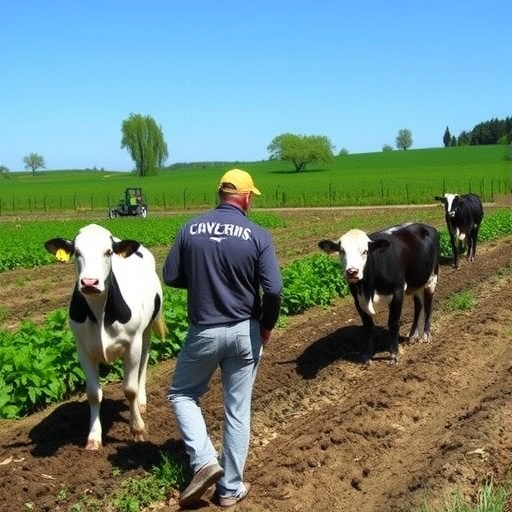A groundbreaking long-term study conducted in the North China Plain has unveiled a compelling strategy to mitigate agriculture’s environmental impact while sustaining robust crop yields. The research demonstrates that integrating organic manure with synthetic fertilizers fundamentally enhances soil quality and significantly reduces emissions of nitrous oxide (N2O), a greenhouse gas approximately 300 times more potent than carbon dioxide. This dual benefit arises from soil microbiome shifts, orchestrated through a meticulous balance of nitrogen cycling microbial guilds, providing a promising roadmap for sustainable intensification in agriculture.
This innovative research, carried out by teams from Hainan University and the Chinese Academy of Sciences, involved an exhaustive experimental setup comparing four distinct fertilization regimes: no fertilizer, conventional synthetic fertilization, an optimized synthetic fertilizer rate, and a balanced blend combining manure with synthetic nitrogen inputs. The integrated manure-synthetic treatment emerged as a superior approach, elevating both soil organic carbon and total nitrogen levels, which collectively enhanced soil fertility without compromising crop productivity. These improvements herald a paradigm shift, challenging conventional reliance solely on high synthetic fertilizer applications.
Crucially, the study sheds light on the mechanistic underpinnings behind the environmental outcomes, elucidating the pivotal role of nitrogen-cycling soil microbes. Advanced molecular tools such as high-throughput gene sequencing allowed the researchers to profile microbial communities with unprecedented resolution. They discovered that plots receiving integrated manure amendments boasted a substantial enrichment of microbes harboring the nosZ gene, which encodes nitrous oxide reductase—an enzyme responsible for the terminal step of denitrification that converts N2O into inert nitrogen gas (N2). This microbial community composition strategically suppresses net N2O emissions, offering a biological lever for climate mitigation.
By contrast, the conventional synthetic fertilization appeared to promote microbial populations that favor pathways producing greater N2O emissions. This dichotomy between microbial guilds highlights that the environmental footprint of fertilization practices is mediated not just through chemical inputs but critically via their influence on soil microbial ecology. The findings validate the deterministic selection imposed by fertilizer regimens on nitrogen-transforming microbes, suggesting that judicious soil management can predictably steer microbial functional groups towards either exacerbating or alleviating greenhouse gas emissions.
The implications of these deterministic microbial shifts extend into ecological theory, where both deterministic (environmental selection) and stochastic (random) processes interplay to assemble microbial communities. The study emphasizes that nitrogen cycling guilds associated with nitrification and denitrification are predominantly shaped by deterministic forces driven by the soil environment and nutrient inputs. Thus, managing these environmental parameters through fertilizer combinations can reliably engineer soil microbiomes to functionally enhance nitrogen retention and reduce harmful emissions.
Importantly, the agricultural outcomes parallel these microbial and biochemical transformations. The manure-plus-synthetic fertilizer treatment preserved crop yields on par with high synthetic input plots while simultaneously boosting soil quality metrics. This dual success suggests that integrated nutrient management reconciles the often opposing goals of maximizing food production and minimizing environmental harm, aligning with global sustainability targets. The strategy also builds soil resilience via increased organic carbon, potentially improving water retention and nutrient cycling.
This research punctuates the urgent need for sustainable fertilizer management innovations within the broader context of climate change mitigation. Nitrous oxide emissions from agriculture constitute a significant source of anthropogenic greenhouse gases, with conventional synthetic fertilizer use intensifying this problem. By demonstrating a viable approach to reduce N2O emissions through microbial ecology manipulation, this study offers actionable insights that could transform fertilizer guidelines and farm practices worldwide.
The molecular ecological approach employed in this study represents a vanguard methodology in agroecosystem research. High-throughput gene sequencing combined with ecological modeling enabled precise dissection of microbial guild dynamics seldom captured in traditional soil science. These techniques illuminate how fertilization strategies intricately shape microbiome composition and function, highlighting the role of microbial genes such as nosZ as bioindicators and functional targets for emission mitigation.
Looking forward, the researchers advocate extending this integrative manure-fertilizer approach to diverse agroecosystems and cropping systems to validate its efficacy broadly. Areas warranting further investigation include economic feasibility, farmer adoption challenges, and agronomic optimization under varying climatic and soil conditions. Understanding these socio-ecological dimensions is critical to scaling the benefits observed in the North China Plain globally and fostering resilient, climate-smart agriculture.
In essence, this study charts a compelling future where synergistic fertilizer management catalyzes beneficial microbiome assembly, improves soil health, sustains crop productivity, and substantially abates climate-altering greenhouse gas emissions. This ecological engineering of soil microbial communities represents a promising frontier in agroecology, merging molecular biology with practical farming to address some of the most pressing environmental challenges of our time.
By harnessing the deterministic forces that govern nitrogen cycling guilds, integrated manure application emerges as a strategic leverage point to reduce nitrous oxide emissions. This novel insight reframes fertilizer applications not merely as nutrient inputs but as ecological signals that sculpt microbial functions with climate implications. Such knowledge empowers farmers and policymakers to enact science-driven interventions that reconcile agricultural productivity with planetary boundaries.
As climate change pressures mount, innovations like this highlight the essential role of microbiome-centric strategies in sustainable agriculture. They underscore that the soil beneath our feet is not just inert substrate but a vibrant, dynamic ecosystem capable of mitigating environmental stresses when managed with scientific precision. This research paves the way for a transformative approach that could redefine the future of fertilization, food security, and climate resilience.
Subject of Research: Not applicable
Article Title: Integrated manure application enhances soil quality and reduces nitrous oxide emissions by deterministically shaping N cycling guilds
News Publication Date: 17-Oct-2025
Web References:
DOI link
References:
Wang Z, Li Y, Liu X, Ju X. 2025. Integrated manure application enhances soil quality and reduces nitrous oxide emissions by deterministically shaping N cycling guilds. Nitrogen Cycling 1: e007
Image Credits: Zhujun Wang, Yue Li, Xinyuan Liu & Xiaotang Ju
Keywords:
Microbial diversity, Genetic analysis, Soil science, Environmental sciences




